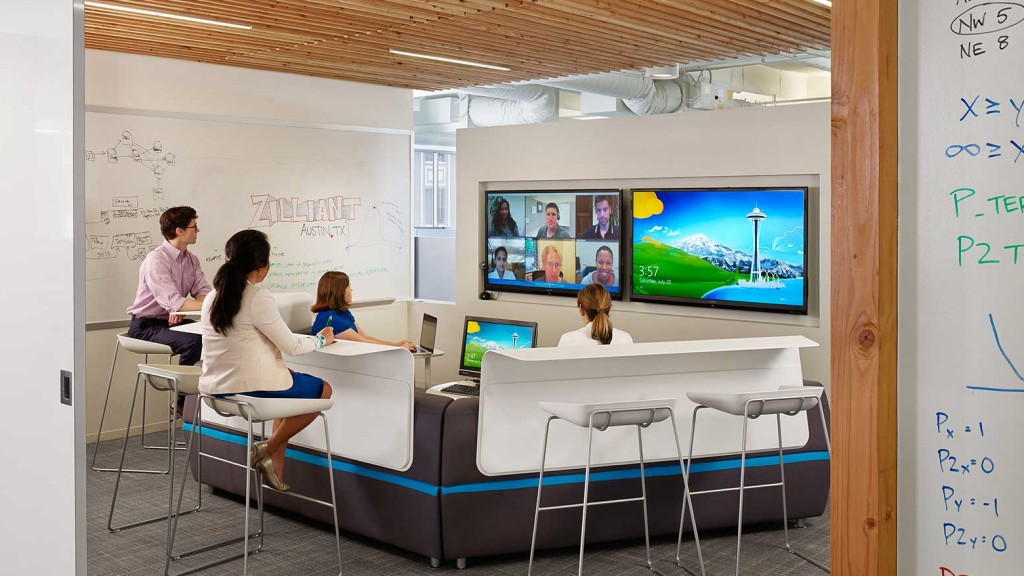How does design drive business performance?
The 2006 U.S. Workplace Survey
What We Did
Note: this report is part of an ongoing series of research on the workplace - view the latest U.S. Workplace Survey here
We conducted a survey of more than 2,000 American office workers to understand the connection between job satisfaction, productivity, innovation, workplace design issues, and worker state of mind. This study built on knowledge gained through Gensler’s 2005 UK Workplace Survey, “These Four Walls”: Workplace design has a significant impact on job satisfaction, productivity, recruitment, and retention. We commissioned D/R Added Value, an independent research firm, to conduct the survey and ensure a comprehensive respondent pool covering eight industries with equal regional representation across the continental United States.
The Context
The design of the workplace has always paralleled what is happening in business, from a process-focused approach in the 1980s to a more nuanced 21st-century approach that considers the intersection of process, technology, and people. At the time of this survey, myriad factors were driving the birth of a new age in business. A thriving knowledge and services sector had moved to the heart of the US economy, driving demand for smart, skilled, and creative professionals.
From our perspective, this new age was characterized by three distinct factors:
- Increased globalization was creating new markets and opportunities, empowered by technological advances allowing work to occur in distributed and remote locations.
- A new workforce of unprecedented diversity—people from different cultures and countries working together at the same time that the US workplace was beginning to host four generations at work.
- New responsibilities prompted by increased social consciousness in the business world that shifted the design and provision of sustainable environments from an option to a mandate.
The Results
In 2006, the average American office worker was feeling increased pressure and higher work expectations— paralleling findings from our 2005 UK Workplace Survey. On a 1-to-5 scale (5 being the highest), average job satisfaction was rated at 3.6. When asked about their offices, 88% of respondents noted the quality of their work environment was important to job satisfaction and 84% reported that they accomplished their best work at the office. Of the respondents, 49% said that their best ideas were developed at their desks, and 67% felt they were more effective when working closely with coworkers. These results revealed opportunities for businesses to improve employee productivity through better-designed workplaces. In fact, when asked if they would be willing to work an extra hour per day if they had a better working environment, 49% of respondents said yes.
What This Means
Workplace quality makes a difference. Improving the quality of the physical environment in which employees work is an opportunity to improve satisfaction and performance. Respondents overwhelmingly agree that workplace design is important and that better design and layout of workplaces can result in better overall employee performance.
Office design influences productivity. Nine out of ten respondents believe that workplace design affects their productivity, and respondents noted a potential increase of 21% in the amount of work they could perform if given a better-designed work environment. This closely parallels our UK findings in which respondents reported a potential 19% productivity increase.
Workers see value in collaboration. Employees intuitively understand the value of proximity and connection to their colleagues as it relates to both effectiveness and creativity. There is an opportunity for organizations to improve the connection—only 50% of respondents at the time of this survey believed that their current workplace design encouraged creativity and innovation, and only a third of respondents believed that creating a productive workplace was a priority for their company.
High-quality design is a competitive advantage. As competition for talent increases, employers are prompted to explore more ways to attract and retain the best and the brightest. The workplace is a key tool not only to keep employees, but to keep them productive and engaged. Respondents agreed—88% of C-level/upper-management respondents believed that the workplace has a positive impact on a company’s bottom line, and 92% of respondents agreed overall that better workplace design can make a company more competitive.
What’s Next?
We used the results of this survey to drive client conversations across the US, as well as to inform ongoing research into the connection between workplace and business success. Clients overwhelmingly agreed on the potential of workplace design to drive productivity, collaboration, and competitiveness. Our conversations also drove productive discussions about external factors changing the ways in which we work—factors that continue to shift as our research progresses. Those change-makers include diversity, distance, responsibility, and the evolving role of work modes as important to our understanding of today’s knowledge worker. The need to further explore work modes informed the development of Gensler’s Workplace Performance Index (WPI) and the 2008 research that built upon the findings from this study.
Learn More
Year Completed
2006
Comments or ideas for further questions we should investigate?
